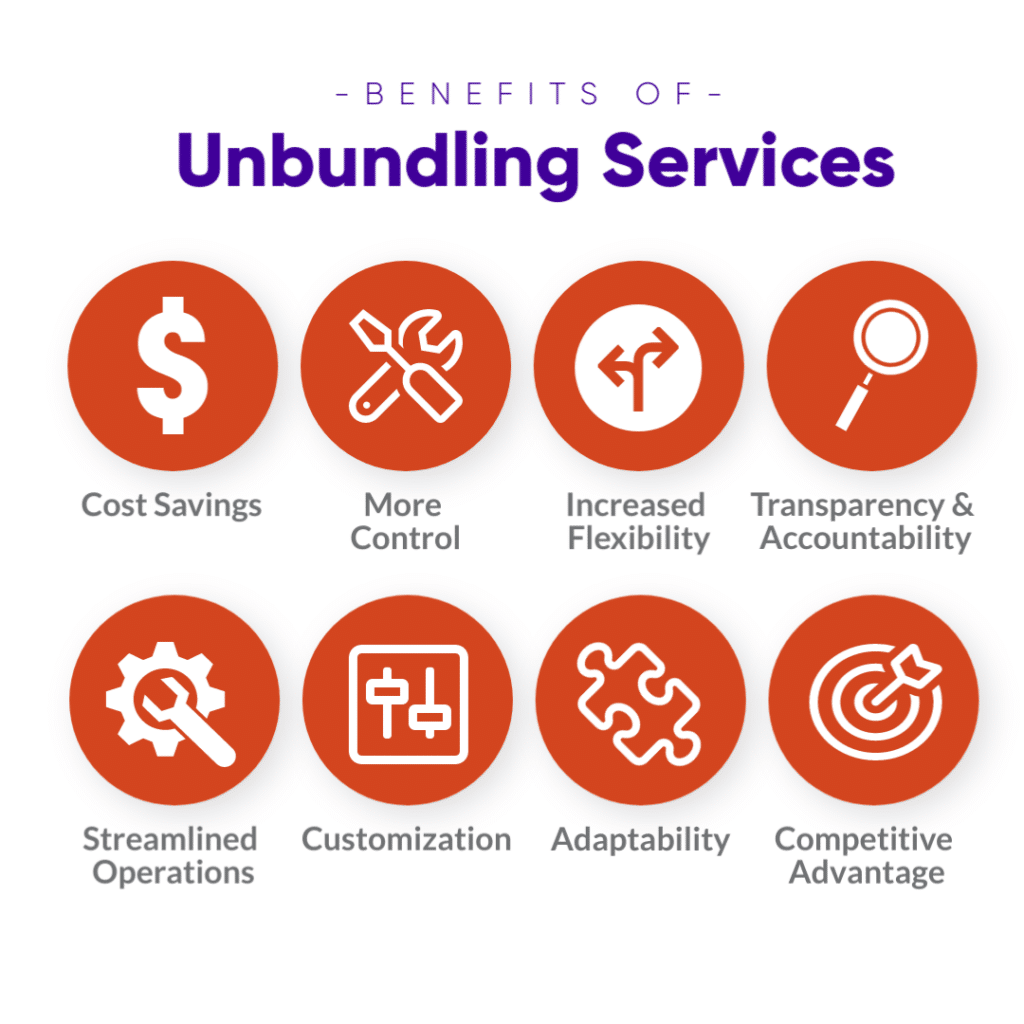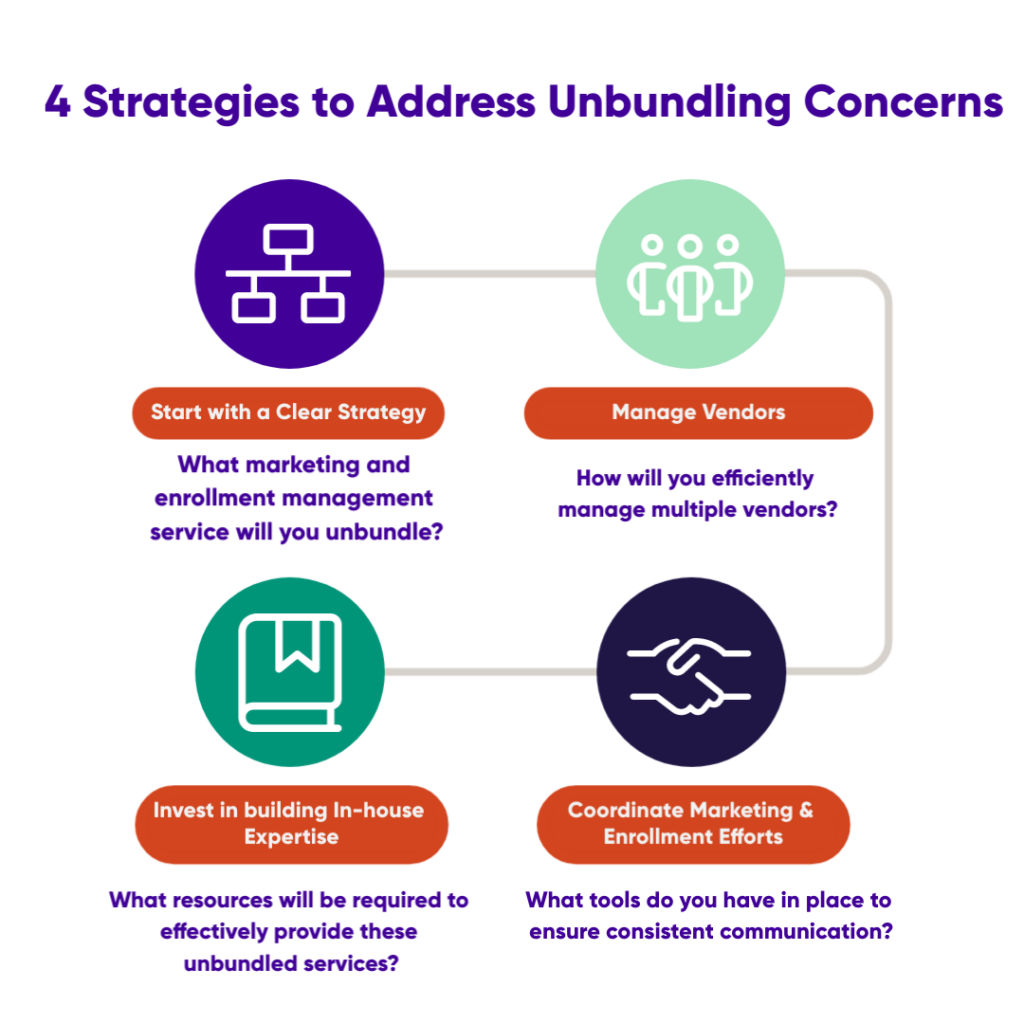Transition Away from OPMs to Unbundled Services in Higher Education

Moving Away from OPMs and Enrollment Management Services
Higher education is undergoing a shift as institutions are actively disengaging from Online Program Management (OPM) providers. In the past, these providers were sought after for their expertise in marketing and enrollment management services, making them the go-to solution for universities looking to improve their online higher education programs. However, times are changing, and institutions are now looking towards unbundled services as an alternative to OPM providers. This movement reflects a growing desire for institutions to regain greater control over their online programs. To understand this transformation better, let’s explore what OPM providers are and their role in higher education.
What is OPM (Online Program Management) in Higher Education?
Before we dive into the shift away from OPM providers, let’s take a moment to understand how they became the norm in higher education. OPMs emerged in the early 2000s as a response to the growing demand for online education. They offered a suite of services in an easy-to-understand bundle, including marketing, enrollment management, and course development as a package deal. OPM providers promised to help universities ideally grow revenue through online program enrollment growth, increased access to new markets, student retention, and revenue sharing. Institutions are now taking a step back and rethinking the tradeoffs that come with using OPM providers. They’re realizing that they need more control and ownership over their online programs, and the costs involved are making them question the value and long-term sustainability of sticking with OPMs.
Unpacking the Benefits of Online Program Management in Higher Education
Partnering with an OPM provided colleges and universities with a fast pass to develop and expand their online programs while reducing financial risks through shared risk. They provided the experience and tools needed to navigate the complexities of online education effectively, even handling marketing and enrollment, lightening the institutional load.
However, OPM partnerships were not always sunshine and rainbows. Using an OPM comes at a cost, both financially and in terms of relinquishing a great deal of control over academic programs. These partnerships often involve revenue-sharing agreements, which means a portion of the program’s earnings goes to the OPM provider.
They had long contracts that made it tough to walk away. Plus, quite the tussle over who owns and controls academic programs, stirring up conflicts among faculty and staff. The increasing possibility of government oversight complicates matters further.
Lastly, some universities have faced challenges in making data-driven decisions effectively because of the limited transparency regarding marketing data and the effectiveness of campaigns across the entire student journey.
The shift away from OPMs towards unbundling services in higher education is driven by a desire for greater control over marketing and enrollment management strategies, financial considerations, and ownership of the academic process in online programs. As institutions seek more autonomy in managing their online education initiatives, one area that has gained particular attention is the unbundling of marketing and enrollment management services.
What Is Unbundling Marketing and Enrollment Management Services?
Unbundling is essentially the opposite of the all-in-one approach OPMs offer. Instead of relying on a single provider for everything, institutions choose which services would provide the most benefit and have more control over how services and solutions tie into campus capabilities.
For example, a university may opt to combine enrollment management and digital marketing services to be handled by a marketing agency while keeping its brand marketing efforts in-house. The ability to pick and choose specific services gives the university more control and flexibility to tailor their online program management strategy to their specific needs.
Benefits of Unbundling Services
Unbundling services in the higher education market isn’t just a trend; it’s a strategic move that empowers universities to optimize their marketing and enrollment management strategies. Unbundling enrollment growth services provide the school control, flexibility, transparency, and the ability to adapt to a rapidly evolving educational landscape.
Let’s dive into the reasons behind the increasing popularity of unbundling services in higher education and the tangible benefits gained from unbundling:

- Cost Savings: Unbundling services allows universities to be financially savvy. By picking and choosing only the services they truly need, they can cut down on unnecessary expenses. This is especially appealing when compared to the potentially hefty costs associated with partnering with an all-in-one OPM provider.
- More Control: Rather than being tied to the predetermined destination and schedule of public transportation, you’re driving your own car. You can go wherever you want, whenever you want. That’s the kind of control universities gain with unbundling. They’re not dependent on a third party for all their marketing and enrollment management needs. They can take the wheel, make quick adjustments, and navigate their course autonomously.
- Increased Flexibility: Unbundling gives colleges and universities the power of flexibility. They can tailor their enrollment management strategies to their exact needs and adapt swiftly as the higher education landscape continues to evolve.
- Transparency and Accountability: Unbundling services promote transparency. Higher ed institutions can see what each service provider is up to, how they’re performing, and where every dollar is going. This transparency breeds accountability, ensuring you get value for your investment.
- Streamlined Operations: Unbundling services streamline operations. Each specialized service provider focuses on what they do best, making processes more efficient and effective.
- Customization: Each institution is unique and wants marketing and enrollment strategies to reflect its and student experience. Unbundling provides the opportunity to customize your approach, allowing you to handpick providers that align perfectly with your goals, values, and brand.
- Adaptability: In a world where change is the only constant, adaptability is crucial. Unbundling services enable colleges and universities to pivot quickly when needed. With the help of market research, they can respond to shifts in student demand, market dynamics, and technological advancements with agility.
- Competitive Advantage: Unbundling allows universities to create a more tailored, cost-effective, and agile approach to attracting and enrolling students. This approach can help them stand out in a competitive market, adapt to changing trends, and retain greater control over their academic offerings and brand identity.
Unbundling services in higher education is a strategic decision that empowers universities to enhance their marketing and enrollment management strategies. It’s centered on control, flexibility, transparency, and adaptability in a swiftly changing educational environment. It’s a transformative shift worth keeping an eye on, as it’s reshaping the higher education landscape.
Challenges of Unbundling Services
While unbundling services in higher education offers a host of benefits, it’s not all smooth sailing. One significant challenge universities face is the increased demand for in-house expertise and resources. With multiple services to manage independently, institutions must build and optimize internal teams to handle the workload effectively. Moreover, coordinating with multiple vendors can provide logistical challenges. Ensuring that all the pieces of the puzzle fit together seamlessly requires active management and constant communication with internal and external teams. Lastly, there’s a danger of siloing and fragmentation of services.
Without careful oversight, different departments and services may become isolated, leading to inefficiencies and a disjointed student experience. The rewards of unbundling are appealing, and higher ed institutions that navigate these challenges skillfully reap the full benefits of developing an unbundled enrollment management strategy.
How to Transition Away from an OPM in Higher Education?
Shifting away from an OPM provider is a strategic move that requires careful planning and execution. The transition process starts with assessing current needs, identifying internal strengths, and formulating a well-structured plan. With the right plan in place, universities are able to choose vendors wisely and then manage the transition diligently to ensure a successful shift.
Quick Tips for Transitioning Away from Your Current OPM Provider:
- Start early: The transition process can take several months or years. It is important to start planning early to ensure that the transition is smooth and successful.
- Communicate regularly. Keep students, faculty, and staff informed of the transition process and address any concerns promptly.
- Be flexible. Things do not always go as planned, so it is important to be flexible and make transition plan adjustments as needed.
- Celebrate successes. Be sure to celebrate the successes of the transition team and to recognize the challenging work of everyone involved.
- Transitioning away from an OPM provider can be a challenging process, but EducationDynamics can help be your guide to exiting your current OPM agreement.
Strategies for Overcoming the Potential Drawbacks of Unbundling
When it comes to unbundling services in higher education, having a solid strategy is key. Consider these strategies to navigate the potential challenges:
- Begin with a clear unbundling strategy: Identify which marketing and enrollment management activities to unbundle, choose the right vendors to partner with, and set a realistic implementation timeline.
- Implement a vendor management system: Develop policies, establish effective communication channels, and create dispute resolution processes for managing multiple vendors efficiently.
- Invest in building in-house expertise: Whether through staff training or new hires, bolster your team’s skills to handle unbundled services effectively.
- Carefully coordinate marketing and enrollment efforts: Ensure alignment to avoid conflicting messages across the student consideration and enrollment process.
By following these strategies, you can effectively overcome the potential challenges that may arise when unbundling services, making the transition smoother and more successful.

Making Informed Choices: Unbundled Services vs. OPM in Higher Education
As the landscape of higher education continues to evolve, so do the strategies for marketing and enrollment management. While OPM in higher education was a popular choice for institutions in the past, unbundled services are now emerging as a preferred option for many colleges and universities.
To explore how EducationDynamics, the largest provider of unbundled marketing and enrollment management solutions for online and adult-focused higher education, can support your institution’s success, reach out today and take the next step toward a brighter future for your online programs. Your institution’s success is just a conversation away!